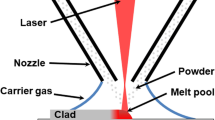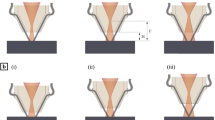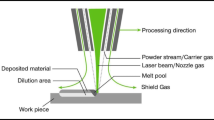Abstract
The combination of additive manufacturing and incremental sheet forming offers great flexibility in the manufacture of function-integrated parts. In this study, both processes were carried out by the same CNC machine. This offers the possibility to manufacture large-scale lightweight parts with smaller additive parts on it in one machine and clamping device. Additionally, the process combination can lead to a reduced energy and material consumption for small batch sizes. DC01 sheets are used as a substrate with two different initial conditions. The first condition is as delivered steel sheet and the second is an incrementally formed with a thickness of 0.5 mm. The additive manufacturing was conducted by laser metal deposition (LMD). The powder material is a stainless steel 316 L. A segmentation of the cladding surface was applied and the path strategy of the laser movement was varied simultaneously to analyse the warpage of the thin substrate. It is shown that there is a dependency between the build-up strategies and the melt pool temperature, the thermal distortion, the dilution and the size of the cladding area. A segmentation of the working surface causes a lower melt pool temperature and thermal distortion. The lower melt pool temperature also generates a reduced dilution zone.









Similar content being viewed by others
Abbreviations
- A Cl :
-
Cladding area
- A Su :
-
Surface of substrate
- ∆T :
-
Temperature gradient
- t 0 :
-
Initial sheet thickness
- t 1 :
-
Sheet thickness after incremental sheet forming
- Ψ :
-
Wall angel
- w :
-
Out-of-plane distortion
References
Weller, C., Kleer, R., & Piller, F. T. (2015). Economic implications of 3D printing: Market structure models in light of additive manufacturing revisited. International Journal of Production Economics,164, 43–56.
Tofail, S. A., Koumoulos, E. P., Bandyopadhyay, A., Bose, S., O’Donoghue, L., & Charitidis, C. (2018). Additive manufacturing: Scientific and technological challenges, market uptake and opportunities. Materials Today,21(1), 22–37.
Thompson, S. M., Bian, L., Shamsaei, N., & Yadollahi, A. (2015). An overview of Direct Laser Deposition for additive manufacturing; Part I: Transport phenomena, modeling and diagnostics. Additive Manufacturing,8, 36–62.
Bax, B., Rajput, R., Kellet, R., & Reisacher, M. (2018). Systematic evaluation of process parameter maps for laser cladding and directed energy deposition. Additive Manufacturing,21, 487–494.
Güpner, M., Patschger, A., & Bliedtner, J. (2016). Influence of process parameters on the process efficiency in laser metal deposition welding. Physics Procedia,83, 657–666.
Saqib, S., Urbanic, R. J., & Aggarwal, K. (2014). Analysis of laser cladding bead morphology for developing additive manufacturing travel paths. Procedia CIRP,17, 824–829.
Ghosh, S., & Choi, J. (2007). Deposition pattern based thermal stresses in single-layer laser aided direct material deposition process. Journal of Manufacturing Science and Engineering,129(2), 319.
Alimardani, M., Fallah, V., Khajepour, A., & Toyserkani, E. (2010). The effect of localized dynamic surface preheating in laser cladding of Stellite 1. Surface and Coatings Technology,204(23), 3911–3919.
Corbin, D. J., Nassar, A. R., Reutzel, E. W., Beese, A. M., & Michaleris, P. (2018). Effect of substrate thickness and preheating on the distortion of laser deposited Ti–6Al–4V. Journal of Manufacturing Science and Engineering,140(6), 61009.
Heigel, J. C., Michaleris, P., & Palmer, T. A. (2015). In situ monitoring and characterization of distortion during laser cladding of Inconel® 625. Journal of Materials Processing Technology,220, 135–145.
Petrat, T., Winterkorn, R., Graf, B., Gumenyuk, A., & Rethmeier, M. (2018). Build-up strategies for temperature control using laser metal deposition for additive manufacturing. Welding in the World,62(5), 1073–1081.
Foroozmehr, E., & Kovacevic, R. (2011). Modeling of the effect of path planning on thermokinetic evolutions in laser powder deposition process. Metallurgical and Materials Transactions A,42(7), 1907–1918.
Hölker, R., Jäger, A., Ben Khalifa, N., & Tekkaya, A. E. (2014). Process and apparatus for the combined manufacturing of workpieces by incremental sheet metal forming and manufacturing methods in one set-up. International Patent WO2016045651 A1.
Dittrich, M. A., Gutowski, T. G., Cao, J., Roth, J. T., Xia, Z. C., Kiridena, V., et al. (2012). Exergy analysis of incremental sheet forming. Production Engineering,6(2), 169–177.
Huang, R., Riddle, M., Graziano, D., Warren, J., Das, S., Nimbalkar, S., et al. (2016). Energy and emissions saving potential of additive manufacturing: The case of lightweight aircraft components. Journal of Cleaner Production,135, 1559–1570.
Papke, T., Dubjella, P., Butzhammer, L., Huber, F., Petrunenko, O., Klose, D., et al. (2018). Influence of a bending operation on the bonding strength for hybrid parts made of Ti-6Al-4V. Procedia CIRP,74, 290–294.
Bambach, M., Sviridov, A., Weisheit, A., & Schleifenbaum, J. (2017). Case studies on local reinforcement of sheet metal components by laser additive manufacturing. Metals,7(4), 113.
Pragana, J. P. M., Cristino, V. A. M., Bragança, I. M. F., et al. (2019). Integration of forming operations on hybrid additive manufacturing systems based on fusion welding. International Journal of Precision Engineering and Manufacturing-Green Technology https://doi.org/10.1007/s40684-019-00152-y
Mulay, A., Ben, B. S., Ismail, S., Kocanda, A., & Jasiński, C. (2018). Performance evaluation of high-speed incremental sheet forming technology for AA5754 H22 aluminum and DC04 steel sheets. Archives of Civil and Mechanical Engineering,18(4), 1275–1287.
Shamsaei, N., Yadollahi, A., Bian, L., & Thompson, S. M. (2015). An overview of direct laser deposition for additive manufacturing; Part II: mechanical behavior, process parameter optimization and control. Additive Manufacturing,8, 12–35.
Ali, H., Ghadbeigi, H., & Mumtaz, K. (2018). Effect of scanning strategies on residual stress and mechanical properties of Selective Laser Melted Ti6Al4V. Materials Science and Engineering: A,712, 175–187.
Maaß, F., Hahn, M., Tekkaya, A. E., Dobecki, M., Poeche, A., Brömmelhoff, K., et al. (2019). Forming mechanisms-related residual stress development in single point incremental forming. Production Engineering,13(2), 149–156.
Hornfeck, T. (2008). Laserstrahlbiegen komplexer Aluminiumstrukturen für Anwendungen in der Luftfahrtindustrie (1st ed.). Utz Verlag, München. (Dissertation, Herbert)
Sakkiettibutra, J., & Vollertsen, F. (2011). Possibilities and limitations of geometric simplifications for calculations of residual stresses and distortions. Production Engineering,5(5), 485–495.
Acknowledgements
This work was supported by the Deutsche Forschungsgemeinschaft (DFG, German Research Foundation) in the frame of the project TE 508/68-1.
Author information
Authors and Affiliations
Corresponding author
Additional information
Publisher's Note
Springer Nature remains neutral with regard to jurisdictional claims in published maps and institutional affiliations.
Rights and permissions
About this article
Cite this article
Tebaay, L.M., Hahn, M. & Tekkaya, A.E. Distortion and Dilution Behavior for Laser Metal Deposition onto Thin Sheet Metals. Int. J. of Precis. Eng. and Manuf.-Green Tech. 7, 625–634 (2020). https://doi.org/10.1007/s40684-020-00203-9
Received:
Revised:
Accepted:
Published:
Issue Date:
DOI: https://doi.org/10.1007/s40684-020-00203-9




